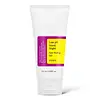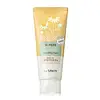What's inside
What's inside
 Key Ingredients
Key Ingredients

No key ingredients
 Benefits
Benefits

 Concerns
Concerns

 Ingredients Side-by-side
Ingredients Side-by-side

Water
Skin ConditioningBambusa Arundinacea Stem Powder
AbrasiveCellulose
AbsorbentGlycerin
HumectantRosa Damascena Flower Water
MaskingPropanediol
SolventButylene Glycol
Humectant1,2-Hexanediol
Skin ConditioningAcrylates/C10-30 Alkyl Acrylate Crosspolymer
Emulsion StabilisingHydroxyacetophenone
AntioxidantLavandula Angustifolia Flower Water
Skin ConditioningTromethamine
BufferingNiacinamide
SmoothingMaltodextrin
AbsorbentEthylhexylglycerin
Skin ConditioningDisodium EDTA
Pentylene Glycol
Skin ConditioningLactobionic Acid
BufferingPapain
Skin ConditioningHyaluronic Acid
HumectantHydrolyzed Hyaluronic Acid
HumectantLactobacillus/Soybean Ferment Extract
Skin ConditioningSodium Hyaluronate
HumectantSodium Metabisulfite
AntioxidantLactobacillus/Rice Ferment
Skin ConditioningCamellia Japonica Flower Extract
EmollientWater, Bambusa Arundinacea Stem Powder, Cellulose, Glycerin, Rosa Damascena Flower Water, Propanediol, Butylene Glycol, 1,2-Hexanediol, Acrylates/C10-30 Alkyl Acrylate Crosspolymer, Hydroxyacetophenone, Lavandula Angustifolia Flower Water, Tromethamine, Niacinamide, Maltodextrin, Ethylhexylglycerin, Disodium EDTA, Pentylene Glycol, Lactobionic Acid, Papain, Hyaluronic Acid, Hydrolyzed Hyaluronic Acid, Lactobacillus/Soybean Ferment Extract, Sodium Hyaluronate, Sodium Metabisulfite, Lactobacillus/Rice Ferment, Camellia Japonica Flower Extract
Water
Skin ConditioningGlycerin
HumectantStearic Acid
CleansingMyristic Acid
CleansingPotassium Hydroxide
BufferingLauramide DEA
Lauric Acid
CleansingGlyceryl Stearate Se
EmulsifyingPotassium Cocoate
EmulsifyingGlycol Distearate
EmollientPotassium Cocoyl Glycinate
Cetearyl Alcohol
EmollientCocamidopropyl Betaine
CleansingPolyquaternium-7
Disodium EDTA
Cocos Nucifera Oil
MaskingButylene Glycol
HumectantLavandula Angustifolia Flower/Leaf/Stem Extract
MaskingSodium Benzoate
MaskingSapindus Mukorossi Fruit Extract
Skin ConditioningCI 17200
Cosmetic ColorantOriganum Majorana Leaf Extract
AntiseborrhoeicMelissa Officinalis Leaf Extract
Skin ConditioningRosmarinus Officinalis Leaf Extract
AntimicrobialPelargonium Graveolens Extract
MaskingMentha Rotundifolia Leaf Extract
TonicOriganum Vulgare Leaf Extract
Skin ConditioningEucalyptus Globulus Leaf Extract
PerfumingMelaleuca Alternifolia Leaf Extract
PerfumingMentha Piperita Leaf Extract
Skin ConditioningThymus Vulgaris Leaf Extract
Skin ProtectingMentha Spicata Flower/Leaf/Stem Extract
MaskingSaponaria Officinalis Leaf Extract
AntimicrobialCI 42090
Cosmetic ColorantWater, Glycerin, Stearic Acid, Myristic Acid, Potassium Hydroxide, Lauramide DEA, Lauric Acid, Glyceryl Stearate Se, Potassium Cocoate, Glycol Distearate, Potassium Cocoyl Glycinate, Cetearyl Alcohol, Cocamidopropyl Betaine, Polyquaternium-7, Disodium EDTA, Cocos Nucifera Oil, Butylene Glycol, Lavandula Angustifolia Flower/Leaf/Stem Extract, Sodium Benzoate, Sapindus Mukorossi Fruit Extract, CI 17200, Origanum Majorana Leaf Extract, Melissa Officinalis Leaf Extract, Rosmarinus Officinalis Leaf Extract, Pelargonium Graveolens Extract, Mentha Rotundifolia Leaf Extract, Origanum Vulgare Leaf Extract, Eucalyptus Globulus Leaf Extract, Melaleuca Alternifolia Leaf Extract, Mentha Piperita Leaf Extract, Thymus Vulgaris Leaf Extract, Mentha Spicata Flower/Leaf/Stem Extract, Saponaria Officinalis Leaf Extract, CI 42090
 Reviews
Reviews

Ingredients Explained
These ingredients are found in both products.
Ingredients higher up in an ingredient list are typically present in a larger amount.
Butylene Glycol (or BG) is used within cosmetic products for a few different reasons:
Overall, Butylene Glycol is a safe and well-rounded ingredient that works well with other ingredients.
Though this ingredient works well with most skin types, some people with sensitive skin may experience a reaction such as allergic rashes, closed comedones, or itchiness.
Learn more about Butylene GlycolDisodium EDTA plays a role in making products more stable by aiding other preservatives.
It is a chelating agent, meaning it neutralizes metal ions that may be found in a product.
Disodium EDTA is a salt of edetic acid and is found to be safe in cosmetic ingredients.
Learn more about Disodium EDTAGlycerin is already naturally found in your skin. It helps moisturize and protect your skin.
A study from 2016 found glycerin to be more effective as a humectant than AHAs and hyaluronic acid.
As a humectant, it helps the skin stay hydrated by pulling moisture to your skin. The low molecular weight of glycerin allows it to pull moisture into the deeper layers of your skin.
Hydrated skin improves your skin barrier; Your skin barrier helps protect against irritants and bacteria.
Glycerin has also been found to have antimicrobial and antiviral properties. Due to these properties, glycerin is often used in wound and burn treatments.
In cosmetics, glycerin is usually derived from plants such as soybean or palm. However, it can also be sourced from animals, such as tallow or animal fat.
This ingredient is organic, colorless, odorless, and non-toxic.
Glycerin is the name for this ingredient in American English. British English uses Glycerol/Glycerine.
Learn more about GlycerinWater. It's the most common cosmetic ingredient of all. You'll usually see it at the top of ingredient lists, meaning that it makes up the largest part of the product.
So why is it so popular? Water most often acts as a solvent - this means that it helps dissolve other ingredients into the formulation.
You'll also recognize water as that liquid we all need to stay alive. If you see this, drink a glass of water. Stay hydrated!
Learn more about Water